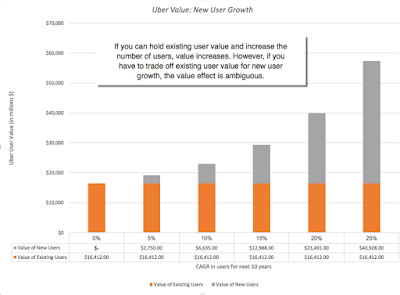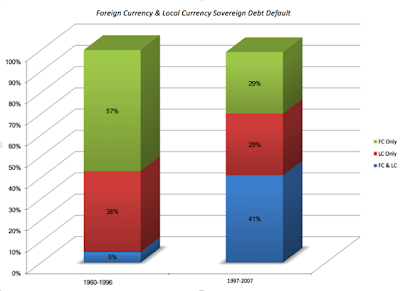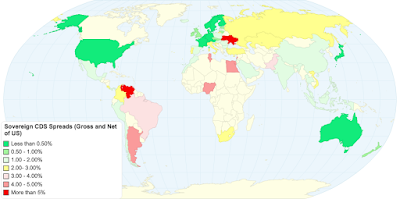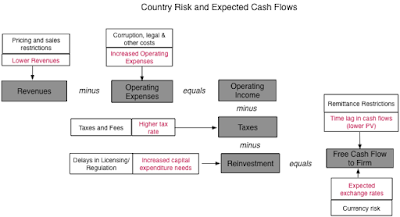It's taken me a while to get here, but in this, the last of my ten posts looking at publicly traded companies globally, I look at pricing differences across regions and sectors. I laid out my rationale for looking at pricing in my most recent post on the topic, where I drew a distinction between good companies, good management and good investments, arguing that investing is about finding mismatches between reality (as driven by cash flows, growth and risk) and perception (as determined by the market).
Multiple = Standardized Price
When looking at how stocks are priced and especially when comparing pricing across stocks, we almost invariably look at pricing multiples (PE, EV to EBITDA) rather than absolute prices. That is because prices per share are a function of the number of shares and are, in a sense, almost arbitrary. Before you respond with indignation, what I mean to say is that I can make the price per share decrease from $100/share to $10/share, by instituting a ten for one stock split, without changing anything about the company. As a consequence, a stock cannot be classified as cheap or expensive based on price per share and you can find Berkshire Hathaway to be under valued at $263,500 per share, while viewing a stock trading at 5 cents per share as hopelessly overvalued.
The process of standardizing prices is straight forward. In the numerator, you need a market measure of value of equity, the entire firm (debt + equity) or the operating assets of the firm (debt + equity -cash = enterprise value). If you confused about the distinction, you may want to review this post of mine from the archives. In the denominator, you can scale the market value to revenues, earnings, accounting estimates of value (book value) or cash flows.
As you can see, there is a very large number of standardized versions of value that you can calculate for firms, especially if you bring in variants on each individual variable in the denominator. With net income, for instance, you can look at income in the last fiscal year (current), the last twelve months (trailing) or the next year (forward). The one simple proposition that you should always follow is to be consistent in your definition of multiple.
The "Consistent Multiple" Rule: If your numerator is the market value of equity (market capitalization or price per share), your denominator has to be an equity measure as well (net income or earnings per share, book value of equity. For example, a price earnings ratio is consistent, since both the numerator and denominator are equity values, and so is an EV to EBITDA multiple. A Price to EBITDA or a Price to Sales ratio is inconsistent, since the numerator is an equity value and the denominator is to the entire business, and will lead to conclusions that are not merited by the fundamentals.
Pricing â A Global Picture
To see how stocks are priced around the world at the start of 2017, I focus on four multiples, the price earnings ratio, the price to book (equity) ratio, the EV/Sales multiple and EV/EBITDA. With each multiple, I will start with a histogram describing how stocks are priced globally (with sub-sector specifics) and then provide country specific numbers in heat maps.
PE ratio
The PE ratio has many variants, some related to what period the earnings per share is measured (current, trailing or forward), some relating to whether the earnings per share are primary or diluted and some a function of whether and how you adjust for extraordinary items. If you superimpose on top of these differences the fact that earnings per share reported by companies reflect very different accounting standards around the world, you can already start to see the caveats roll out. That said, it is still useful to start with a histogram of PE ratios of all publicly traded companies around the world:
Note that of the 42,668 firms in my global sample, there were only 25,493 firms that made it through into this graph; the rest of the sample (about 40%) had negative earnings per share and the PE ratios was not meaningful. While the histogram provides the distributions by regional sub-groups, the heat map below provides the median PE ratio by country:
If you go to the live heat map, you will also be able to see the 25th and 75th quartiles within each country, or you can download the spreadsheet that contains the data. I mistrust PE ratios for many reasons. First, the more accountants can work on a number, the less trustworthy it becomes, and there is no more massaged, manipulated and mangled variable than earnings per share. Second, the sampling bias introduced by eliminating a large subset of your sample, by eliminating money losing companies, is immense. Third, it is the most volatile of all of the multiples as it is based upon earnings per share.
Price to Book
In many ways, the price to book ratio confronts investors on a fundamental question of whether they trust markets or accountants more, by scaling the marketâs estimate of what a company is worth (the market capitalization) to what the accountants consider the companyâs value (book value of equity). The rules of thumb that have been build around book value go back in history to the origins of value investing and all make implicit assumptions about what book value measures in the first place. Again, I will start with the histogram for all global stocks, with the table at the regional level imposed on it:
The price to book ratio has better sampling properties than price earnings ratios for the simple reason that there are far fewer firms with negative book equities (only about 10% of all firms globally) than with negative earnings. If you believe, as some do, that stocks that trade at less than book value are cheap, there is good news: you have lots and lots of buying opportunities (including the entire Japanese market). Following up, letâs take a look in the heat map below of median price to book ratios, by country.
Again, you can see the 25th and 75th quartiles in either the live map or by downloading the spreadsheet with the data. Pausing to look at the numbers, note the countries shaded in green, which are the cheapest in the world, at least on a price to book basis, are concentrated in Africa and Eastern Europe, arguably among the riskiest parts of the world. The most expensive countries are China, a couple of outliers in Africa (Ivory Coast and Senegal, with very small sample sizes) and Argentina, a bit of a surprise.
EV to EBITDA
The EV to EBITDA multiple has quickly grown in favor among analysts, for some good reasons and some bad. Among the good reasons, it is less affected by different financial leverage policies than PE ratios (but it is not immune) and depreciation methods than other earnings multiples. Among the bad ones is that it is a cash flow measure based on a dangerously loose definition of cash flow that works only if you live in a world where there are no taxes, debt payments and capital expenditures laying claim on those cash flows. The global histogram of EV to EBITDA multiples share the positive skew of the other multiples, with the peak to the left and the tail to the right:
Again, there will be firms that had negative EBITDA that did not make the cut, but they are fewer in number than those with negative EPS. Looking at the median EV to EBITDA multiple by country in the heat map below, you can see the cheap spots and the expensive ones.
As with the other data, you can get the lower and higher quartile data in the spreadsheet. As with price to book, the cheapest countries in the world lie in some of the riskiest parts of the world, in Africa and Eastern Europe. China remains among the most expensive countries in the world but Argentina which also made the list, on a price to book basis, drops back to the pack.
EV to Sales
If you share my fear of accounting game playing, you probably also feel more comfortable working with revenues, the number on which accountants have the fewest degrees of freedom. Letâs start with the histogram for global stocks:
Of all the multiples, this should be the one where you lose the least companies (though many financial service companies donât report conventional revenues) and the one that you can use even on young companies that are working their way through the early stages of the life cycle. The median EV/Sales ratio for each country are in the heat map below:
You can download more extensive numbers in the spreadsheet. By now, the familiar pattern reasserts itself, with East European and African companies looking cheap and China looking expensive. With revenue multiples, Canada and Australia also enter the overvalued list, perhaps because of the preponderance of natural resource companies in these countries.
Pricing â Sector Differences
All of the multiples that I talked about in the last section can also be computed at the industry level and it is worth doing so, partly to gain perspective on what comprises cheap and expensive in each grouping and partly to look for under and over priced groupings. The following table, lists the ten lowest-priced and highest priced industry groups at the start of 2017, based upon trailing PE:
In many of the cheapest sectors, the reasons for the low pricing are fundamental: low growth, high risk and an inability to generate high returns on equity or margins. Similarly, the highest PE sectors also tend to be in higher growth, high return on equity businesses. I will leave the judgment to you whether any fit the definition of a cheap company. The entire list of multiples, by sector, can be obtained by clicking on this spreadsheet.
One comparison that you may consider making is to pick and multiple and trace how it has changed over time for an industry group. Isolating pharmaceutical and biotechnology companies in the United States, for instance, here is what I find when it comes to EV to EBITR&D for the two groups over time:
You can read this graph in one of two ways. If you are a firm believer in mean reversion, you would load up on biotech stocks and hope that they revert back to their pre-2006 premiums, but I think you would be on dangerous ground. The declining premium is just as much a function of a changing health care business (with less pricing power for drug companies), increasing scale at biotech companies and more competition.
One comparison that you may consider making is to pick and multiple and trace how it has changed over time for an industry group. Isolating pharmaceutical and biotechnology companies in the United States, for instance, here is what I find when it comes to EV to EBITR&D for the two groups over time:
You can read this graph in one of two ways. If you are a firm believer in mean reversion, you would load up on biotech stocks and hope that they revert back to their pre-2006 premiums, but I think you would be on dangerous ground. The declining premium is just as much a function of a changing health care business (with less pricing power for drug companies), increasing scale at biotech companies and more competition.
Rules for the Road
- Absolute rules of thumb are dangerous (and lazy): The investing world is full of rules of thumb for finding bargains. Companies that trade at less than book value are cheap, as are companies that trade at less than six times EBITDA or have PEG ratios less than one. Many of these rules have their roots in a different age, when data was difficult to access and there were no ready tools for analyzing them, other than abacuses and ledger sheets. In Ben Graham's day, the very fact that you had collected the data to run his "cheap stock" screens was your competitive advantage. In today's market, where you can download the entire market with the click of a button and tailor your Excel spreadsheet to compute and screen, it strikes me as odd that screens still remain based on absolute values. If you want to find cheap companies based upon EV to EBITDA, why not just compute the number for every company (as I have in my histogram) and then use the first quartile (25th percentile) as your cut off for cheap. By my calculations, a company with an EV/EBITDA of 7.70 would be cheap in the United States but you would need an EV to EBITDA less than 4.67 to be cheap in Japan, at least in January 2017.
- Most stocks that look cheap deserve to be cheap: If your investment strategy is buying stocks that trade at low multiples of earnings and book value and waiting for them to recover, you are playing a game of mean reversion. It may work for you, but there is little that you are bringing to the investing table, and there is little that I would expect you to take away. If you want to price a stock, you have to bring in not just how cheap it is but also look at measures of value that may explain why the stock is cheap.
- If you are paying a price, you are "estimating" the future: When I do an intrinsic valuation (as I did a couple of weeks ago with Snap), I am often taken to task by some readers for playing God, i.e., forecasting revenue growth, margins and risk for a company with a very uncertain future. I accept that critique but I don't see an alternative. If your view is that using a multiple lets you evade this responsibility, it is because you have chosen not to look under the hood, If you pay 50 times revenues for a company, which is what you might be with Snap, you are making assumptions about revenue growth and margins, whether you like it or not. The only difference between us seems to be that I am being explicit about my assumptions, whereas your assumptions are implicit. In fact, they may be so implicit that you don't even know what they are, a decidedly dangerous place to be in investing.
YouTube Video
Data Links
Data 2017 Posts
Data Links
- PE, PBV, EV to EBITDA and EV to Sales by Country: January 2017
- PE, PBV, EV to EBITDA and EV to Sales by Industry Group: January 2017
Data 2017 Posts
- Data Update 1: The Promise and Perils of Big Data
- Data Update 2: The Resilience of US Equities
- Data Update 3: Cracking the Currency Code - January 2017
- Data Update 4: Country Risk and Pricing, January 2017
- Data Update 5: A Taxing Year Ahead?
- Data Update 6: The Cost of Capital in January 2017
- Data Update 7: Profitability, Excess Returns and Corporate Governance- January 2017
- Data Update 8: The Debt Trade off in January 2017
- Data Update 9: Dividends and Buybacks in 2017
- Data Update 10: The Pricing Game



























































































